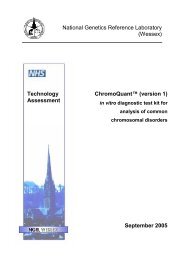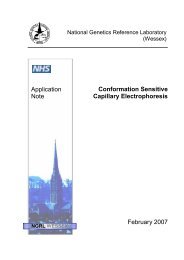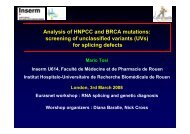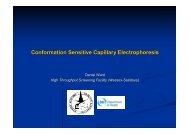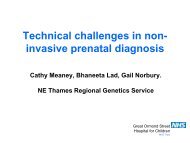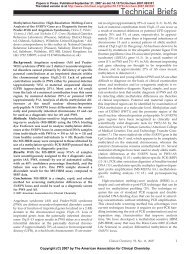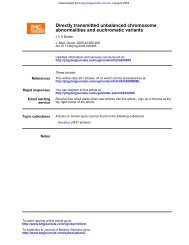Accurate Detection and Quantitation of Heteroplasmic Mitochondrial ...
Accurate Detection and Quantitation of Heteroplasmic Mitochondrial ...
Accurate Detection and Quantitation of Heteroplasmic Mitochondrial ...
You also want an ePaper? Increase the reach of your titles
YUMPU automatically turns print PDFs into web optimized ePapers that Google loves.
196detection methods are therefore important for mutation detectionin elderly patients because this can alleviate the need formore invasive muscle biopsy samples to be taken. In our study10 patients (9 peripheral blood samples <strong>and</strong> 1 muscle biopsy)were found to have the A3243G mutation. The data from thePyrosequencing assays correlated well with results obtained usingPCR-RFLP <strong>and</strong> the assay had a sensitivity <strong>and</strong> specificity<strong>of</strong> 100% with a cut<strong>of</strong>f AQ value <strong>of</strong> 0.39%. The Pyrosequencingassay had very low-level background signals with a meanAQ value for the G allele <strong>of</strong> 0.06% (st<strong>and</strong>ard deviation 0.11)determined by the analysis <strong>of</strong> the normal samples. Using sampleswith known mutation loads it was established that the lowestlevel <strong>of</strong> heteroplasmy that could be detected reliably was1% that produced a mean AQ value <strong>of</strong> 1.73% (st<strong>and</strong>ard deviation0.84) in the Pyrosequencing assay. This threshold level <strong>of</strong>detection should be adequate for most clinical diagnostic laboratories.The A8344G mutation in the tRNA Lys gene was first describedby Silvestri et al. in association with myoclonic epilepsyWHITE ET AL.with red ragged fibers (Silvestri et al., 1993). The pathogenicMELAS <strong>and</strong> MERRF mutations both affect the mitochondrialtRNA genes <strong>and</strong> they have similar effects on the respiratory chainin vitro. As for the MELAS A3243G, there is a correlation betweenpercent heteroplasmy <strong>and</strong> clinical features in muscle biopsysamples where patients with more than 90% mutated DNAin muscle are more likely to have deafness, ataxia, <strong>and</strong> myoclonusthan patients who have mutated DNA present at more than 80%(Chinnery et al., 1997). Unlike the A3243G mutation individualswith A8344G <strong>of</strong>ten have similar levels <strong>of</strong> mutant mtDNA intheir blood <strong>and</strong> muscle. Four patients in this study were found tohave the MERRF A8344G mutation present in peripheral bloodsamples using both Pyrosequencing <strong>and</strong> PCR-RFLP. The level<strong>of</strong> heteroplasmy determined by Pyrosequencing assay correlatedwell to that detected using PCR-RFLP. Again, the Pyrosequencingassay had very low background with the mean AQ value forthe G allele in normal samples being 0.13 (st<strong>and</strong>ard deviation0.5) <strong>and</strong> the assay results were reproducible with a sensitivity<strong>and</strong> specificity <strong>of</strong> 100%.A100% heteroplasmy obtained usingPyrosequencing908070605040302010y = 0.96x + 0.73R 2 = 0.99B100001020304050 60Theoretical % heteroplasmy708090100110% heteroplasmy obtained usingPCR RFLP908070605040302010y = 0.92x − 5.83R 2 = 0.98001020304050 60Theoretical % heteroplasmy708090100110FIG. 3. St<strong>and</strong>ard curves from cloned wild type <strong>and</strong> mutated DNA samples which have been mixed to generate samples withthe A3243G mutation present at levels <strong>of</strong> 0, 1, 2.5, 5, 10, 20, 30, 40, 50, 60, 70, 80, 90, <strong>and</strong> 100% (x axis). Error bars indicatethe st<strong>and</strong>ard deviation for triplicate samples. A: St<strong>and</strong>ard curve for the Pyrosequencing assay showing a linear relationship betweenthe percentage heteroplasmy present in the samples <strong>and</strong> the percentage heteroplasmy detected by the Pyrosequencing assay.The lowest reliable level <strong>of</strong> A3243G detection was 1% (0.5% not tested). B: St<strong>and</strong>ard curve for the polymerase chain reaction-restrictionfragment length polymorphism (PCR-RFLP) assay showing the linear (solid line) <strong>and</strong> quadratic (dotted line; y 0.005x 2 0.42x 0.94, R 2 0.99) relationships between the percentage heteroplasmy present in the samples <strong>and</strong> the percentageheteroplasmy determined by analysis <strong>of</strong> the cleaved <strong>and</strong> uncleaved peak areas after restriction digestion. The lowest reliablelevel <strong>of</strong> A3243G detection was 5%.



